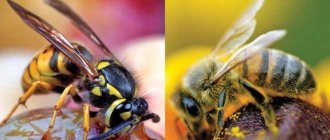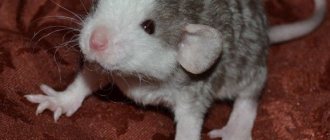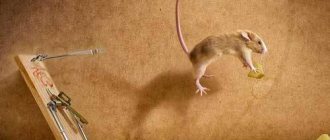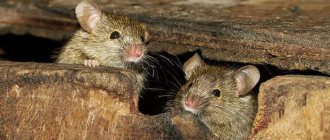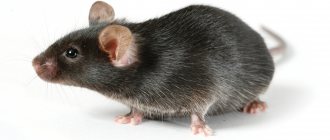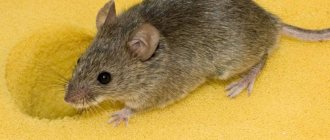Today we will continue with you the topic of animals that children can keep at home. This time we will talk about white mice and rats. Grayish or brown mice in our homes, in general, cannot count on warm hospitality. Children get mice for entertainment that have beautiful white fur and red eyes. Brown field mice are found in huge numbers in some places, and occasionally a white mouse is also found among them, sharply different from the latter. When hunting for her for a certain time, you need to constantly throw her bait in the form of grains of nuts, small pieces of bread, etc.
Having trained the mouse to systematically appear at a certain period of time in the same place, a mousetrap is placed there, arranged in such a way that the mouse, once caught in it, remains alive. When properly cared for, caught mice quickly become tame.
But, naturally, it is much easier to buy an already tamed white mouse or rat in a store. A cage for it can also be purchased in the same store, but we will consider another option, namely, we will make a cage for a white mouse with our own hands.
White mouse: appearance of the species
The white mouse is a direct descendant of common house mice. As a species, it appeared about 3,500 thousand years ago. Now this is one of the most common types of rodents. They live everywhere except in permafrost regions and highlands.
The white mouse is a popular pet
For your information! Closest relatives are jerboas, hamsters, chinchillas
The white mouse was initially considered a noble and unusual animal due to its non-standard color. She was kept in houses and temples in China and Japan, as well as in Mediterranean countries. There, the image of a white mouse was sacred: it was not just bred for aesthetic pleasure, but was even worshiped. The adaptability and cleanliness of the animal, as well as the ability to be friendly towards representatives of its species, were noted.
Keeping animals began more than 1.5 centuries ago. ago, after their mass import to Europe for experimental research.
For more than a century, white mice have been used as experimental animals.
How to make a room for a white mouse
The box described in the previous article about squirrels can serve as a room for mice, with the only difference being that this box is much larger and, in addition, is equipped with a thicker wire mesh. In one of the upper corners of the box there is a small box used for resting and sleeping for mice. The makeshift bedroom is lined with hay, soft scraps of fabric, wool, etc.
More experienced children who know how to build houses build a suitable room for mice, decorating it with windows and small towers. Inside such a house there are crossbars and ladders, which white mice deftly climb to get the delicacy placed there for them.
The cage or house in which white mice are placed must be kept absolutely clean, for which purpose the litter is taken out of them every day, etc. The bedding that white mice use for sleeping must also be replaced as often as possible with a new one. This replacement should be done at least every two to three days.
Description of the size and character of white house mice
The white mouse is one of the small representatives of rodents.
What a mouse looks like - description of appearance and size
Appearance:
- size no more than 12-12.5 cm in length;
- the tail occupies over 50% of the entire body, 6-11 cm;
- weight 15-30 g;
- the muzzle is sharp, elongated;
- eyes large, round; they can be either dark or red (in albinos). They are characterized by excellent vision;
- The ears are small and round in shape.
Character
Mice are active creatures. They are in constant motion. If they are not running and climbing, then they wash themselves, gnaw, and dig.
Note! They are characterized by friendliness. There have been no recorded cases of aggressive behavior towards their relatives or other small animals. They can quite easily share their food with others.
White mice behave trustingly with people. Tamed individuals recognize the owner and can take food from their hands.
You need to hold the animal in your arms carefully
In relation to their offspring, white mice are caring parents. They not only do not abandon newborn mice, but take care of them, decorate the house for their offspring, and not only females, but also males do this.
Content
When it comes to keeping these pets, they are absolutely unpretentious: they do not require special food, large space, or exorbitant financial costs. There is no need to rack your brains for a long time about what a white mouse eats.
These rodents are easy to train and, having gone through the path of adaptation and getting used to the owner, they do not hesitate to go into his arms, although it is not recommended to let them out of the cage unattended: if they hide, then finding them and catching them will not be the easiest task.
Requirements for a white mouse's home:
Some owners prefer to keep rodents in aquariums. This is not the best solution, because the walls easily fog up, and cleaning the aquarium is much more difficult. If you still decide to take this step, then do not forget to buy a metal mesh with small holes in the kit: this will allow air to get inside, but you will be able to avoid your pet’s attempts to escape.
If you plan to keep only one rodent or a pair,
a cage measuring 30x15x20 cm will be enough for them .
If you plan to have more than two mice, then it is better to immediately buy a house measuring 50x20x20 cm. This space is enough for 2-3 pairs. In the case of such a neighborhood and the presence of several females, they most often group together, make one nest for everyone and raise newborns together. Under such conditions, even if one of the females dies, the remaining ones will feed her cubs along with their own, becoming “foster mothers” for them. What should be in the cage:
What to feed white mice at home
White mice are unpretentious in food. Despite this, it is very important to maintain a balanced diet, as with any animal.
White ferret - description of the species, size and character
A rodent's diet may include:
- grain crops (oats, millet, barley, millet, corn);
- pumpkin, sunflower, flax, hemp seeds;
- vegetables (cabbage, root vegetables);
- fruits (apples, pears);
- green plants (leaves and stems);
- cottage cheese;
- boiled milk;
- animal food: mealworms or other invertebrates, some boiled meat;
- special granulated food for mice. Particular attention should be paid to the composition of the product. It should not contain harmful chemical dyes.
It is important to periodically add vitamin and mineral complexes to the diet to maintain and improve the animal’s health. This is especially useful and necessary for pregnant and lactating individuals.
Important! Salty, fatty, spicy, smoked and fried foods, as well as confectionery sweets, are strictly contraindicated for pets.
White mice should be fed no more than once a day. The norm is 1 teaspoon per individual. The mice are given unboiled tap or well water, but most importantly, clean water.
White mouse food
In order for the pet to be healthy , the owner should remember that the diet must be balanced. The daily consumption rate is 50 grams of food feed. You can use it as food:
- Cereals.
- Vegetables.
- Curd products.
- Grass is a complete source of minerals necessary for the normal functioning of the rodent’s body.
- If the owner decides to use the seeds as feed, then it should be remembered that they must be raw.
- Fertilized and lactating females need fish oil.
- It is advisable to give your pet some raw meat once a week.
- Under no circumstances should mice be fed sweet, salty or fatty foods.
The dosage of food should be optimal . Although rodents live in peace and harmony and are ready to share food with each other, they should not be limited in food. Also, excessive consumption of food will not benefit them.
To summarize, we can say that these peaceful and active animals do not require excessive care when living as a pet. Periodic change of bedding, arrangement of the house and a balanced diet is all that is needed for the healthy growth of a decorative mouse. If you do not neglect these rules, then a happy animal will, without a doubt, thank its owner with love and curiosity, and will become a best friend who will not only be a pet, but also part of the family.
Features of care and maintenance of white mice at home
Persian cat: description of breed and character, how long they live
Caring for white mice itself is not difficult. They are quite unpretentious creatures. Animals can be tamed quite quickly. Starting from the age of one month, the mouse can already be picked up. Soon he himself will recognize the owner and go into his arms. Tamed animals are easy to train - make them perform all sorts of tricks.
Important! When breeding white mice, it is necessary to take into account that they emit a specific smell that not everyone can tolerate, especially when there are many individuals in a small area.
Much attention must be paid to the animals’ housing. The habitat of rodents must be at least 40x40 cm in size for one individual. If you plan to have a couple or three individuals, then the home should be more spacious.
You can place the animal in a cage, a special plastic box or an aquarium. It is worth paying attention that the space between the bars of the cage does not exceed 10 mm, otherwise the rodent will easily and quickly slip through the gap and get lost in the corners of the apartment.
When using an aquarium, the top must be covered with a special lid with ventilation holes or a mesh. The floor of the home must be covered with paper and sprinkled with shavings, sawdust, and hay.
Note! It is also necessary to take into account the location of the cage. Do not place the house with mice in a draft or near the heating system. The temperature in the room where animals are located should not exceed 20-22 ° C, air humidity - 50-60%.
A small container, preferably made of durable material, should be placed in the cage itself. This will create a kind of cozy mink. It is advisable to place perches or shelves for climbing and a running wheel in the mouse house. This will allow the animals to be active and not become fat in captivity.
It is better to use a feeder made of durable material. Special automatic devices in the form of glass tubes with a spout extended to the side are very convenient as drinking bowls. In addition to the main food, you can add hard bread, sticks, and twigs to the feeder, since mice have to sharpen their teeth.
Even when in captivity, mice need to move
Don’t forget to wash the rodent’s house with water and change the bedding in it more often.
Important! You should not place mice of the opposite sex in the same cage unless you plan to breed rodents. These animals are capable of constant and uncontrolled reproduction.
Don’t forget that mice are nocturnal animals, but over time they can adapt to a person’s routine. These rodents sleep on average about 10 hours a day.
Mice, like other living creatures, are susceptible to diseases. The most common among them are such serious diseases as tumors, cystitis, parasitic infections, otitis media, smallpox, salmonellosis, etc. If you suspect a problem, you should immediately contact a veterinarian.
In Russia, white mice are often kept as pets. Sections and clubs for lovers of these decorative rodents are being created. Despite the specific smell, the animal is popular among breeders because it is unpretentious in keeping and feeding. Their curiosity and friendliness are also valued.
House for a decorative mouse
Although these pets are not particularly picky in terms of their maintenance , it is worth knowing some mandatory things regarding housing :
- The cage must be made of metal. The presence of a retractable tray will simplify the process of cleaning the cage and feeding the pet. But when choosing a cage, you should pay attention to the gap between the pallet and the holes. It should be at least 10 centimeters, since if the distance is greater, the mouse will be able to easily crawl into it and its search around the apartment will take a lot of time.
- Requires daily change of litter.
- The cage should be located away from heating devices and drafts.
Some owners believe that an ornamental pet can be placed in an aquarium. This idea is not the best, since glass walls tend to fog up quickly. And cleaning such a home will take much longer than a cage. Even if the owner decides to place his pet in such housing, he should purchase a metal mesh with small holes . This will allow the pet to breathe deeply and protect the owner from escaping his little friend.
What must be present in the cell?
- Small pieces of chalk. If there is a shortage of chalk, then you can place parts from branches in the cage. A rusty piece of bread also works well. These things are necessary for the rodent to sharpen its teeth and to prevent further growth of the incisors and add the necessary minerals to the diet for the healthy growth of the mouse.
- Litter. The most common bedding materials for rodents are paper and sawdust. A good alternative to these materials is hay.
- Wheel. This is perhaps one of the important attributes for the health of a rodent. Due to their activity, mice will not be able to sit still. And it is the running wheel that will remove all the accumulated energy from it.
Character and size
Absolutely all mice of this species are active. Despite their excessive activity, they are absolutely harmless both to their owners and to other decorative rodents in the house. To have several individuals of this species, the owner does not have to acquire several cells. Mice will live in harmony and agreement even in the same territory, provided that they were placed in a cage of the same age. When a newcomer moves in, the mice will show him with all their appearance that this is their territory and he is clearly a stranger here. Often such settlements end in tears for a new mouse. But this case may be the only act of aggression on the part of ornamental rodents.
In addition to its activity and kindness, the white mouse differs from its relatives in its strong parental love. In addition to the female, the male also takes care of the newborn mouse. This phenomenon is rarely seen among animals.
How to breed decorative mice
Pregnancy in a female lasts no more than 21 days. One litter can have up to 7 mice, weighing about 1.5 grams. Like many newborn animals, children of the decorative rodent are born not only blind and deaf, but also completely bald. After a few days of age, little mice develop a small fluff on their backs. After a week after birth, their bodies are completely covered with hair.
The female feeds the offspring for 4 weeks. But, despite this, already two hours after the female has given birth, she is ready for another fertilization.
Upon reaching the age of one month , decorative mice can take care of themselves without the intervention of their parents. Three months after birth, rodents are able to have offspring themselves.
The average lifespan of rodents is 2-3 years. There have been cases where a white mouse has crossed the threshold at 5 years.
House mouse, intelligence and playfulness
Source
Almost every person has acquired a pet at least once in their life. Some prefer common types of pets such as cats and dogs. Some people like exotic reptile species. Well, some owners keep a white mouse as a pet.
has been considered a pet for many years . The origin of these cute animals is controversial. Some sources indicate that the decorative mouse existed before our era. But a more common description of the origin of these mice points to the breeding of ornamental rodent species in laboratories for experiments.
Previously, in many countries there was a belief that if there is a white mouse in the house, it will protect the house from other rodents that can leave the owners without food supplies in a short time. Our ancestors also associated these cute animals with joy. To this day, many people have a favorable attitude towards this decorative animal.



